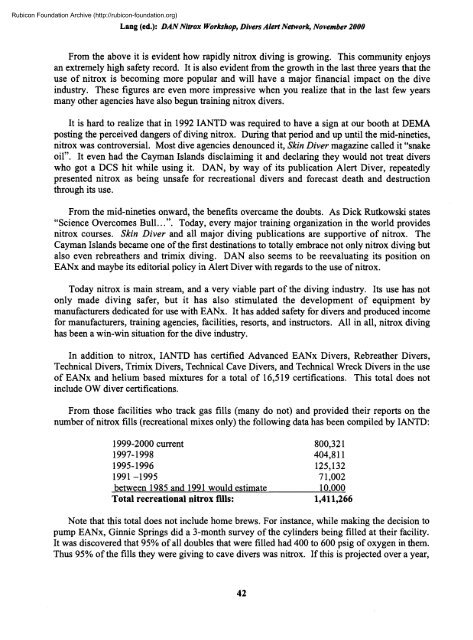Nitrox workshop dings - Divers Alert Network
Nitrox workshop dings - Divers Alert Network
Nitrox workshop dings - Divers Alert Network
Create successful ePaper yourself
Turn your PDF publications into a flip-book with our unique Google optimized e-Paper software.
Rubicon Foundation Archive (http://rubicon-foundation.org)Lang (ed.): DAN <strong>Nitrox</strong> Workshop, <strong>Divers</strong> <strong>Alert</strong> <strong>Network</strong>, November 2000From the above it is evident how rapidly nitrox diving is growing. This community enjoysan extremely high safety record. It is also evident from the growth in the last three years that theuse of nitrox is becoming more popular and will have a major financial impact on the diveindustry. These figures are even more impressive when you realize that in the last few yearsmany other agencies have also begun training nitrox divers.It is hard to realize that in 1992 IANTD was required to have a sign at our booth at DEMAposting the perceived dangers of diving nitrox. During that period and up until the mid-nineties,nitrox was controversial. Most dive agencies denounced it, Skin Diver magazine called it "snakeoil". It even had the Cayman Islands disclaiming it and declaring they would not treat diverswho got a DCS hit while using it. DAN, by way of its publication <strong>Alert</strong> Diver, repeatedlypresented nitrox as being unsafe for recreational divers and forecast death and destructionthrough its use.From the mid-nineties onward, the benefits overcame the doubts. As Dick Rutkowski states"Science Overcomes Bull...". Today, every major training organization in the world providesnitrox courses. Skin Diver and all major diving publications are supportive of nitrox. TheCayman Islands became one of the first destinations to totally embrace not only nitrox diving butalso even rebreathers and trimix diving. DAN also seems to be reevaluating its position onEANx and maybe its editorial policy in <strong>Alert</strong> Diver with regards to the use of nitrox.Today nitrox is main stream, and a very viable part of the diving industry. Its use has notonly made diving safer, but it has also stimulated the development of equipment bymanufacturers dedicated for use with EANx. It has added safety for divers and produced incomefor manufacturers, training agencies, facilities, resorts, and instructors. All in all, nitrox divinghas been a win-win situation for the dive industry.In addition to nitrox, IANTD has certified Advanced EANx <strong>Divers</strong>, Rebreather <strong>Divers</strong>,Technical <strong>Divers</strong>, Trimix <strong>Divers</strong>, Technical Cave <strong>Divers</strong>, and Technical Wreck <strong>Divers</strong> in the useof EANx and helium based mixtures for a total of 16,519 certifications. This total does notinclude OW diver certifications.From those facilities who track gas fills (many do not) and provided their reports on thenumber of nitrox fills (recreational mixes only) the following data has been compiled by IANTD:1999-2000 current1997-19981995-19961991 -1995between 1985 and 1991 would estimate800,321404,811125,13271,00210.000Total recreational nitrox fills: 1,411,266Note that this total does not include home brews. For instance, while making the decision topump EANx, Ginnie Springs did a 3-month survey of the cylinders being filled at their facility.It was discovered that 95% of all doubles that were filled had 400 to 600 psig of oxygen in them.Thus 95% of the fills they were giving to cave divers was nitrox. If this is projected over a year,42
















